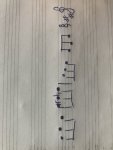dunlustin post_id=64923 time=1544302863 user_id=70 said:
I found:
454, 321, 231, 323
or with just 3 fingers
343, 324, 234, 434 - maybe you wouldnt find the 3 repeat in a book but ...if it works
When faced with something unusual it really is just a case of doing whatever is required, regardless of what is perceived as correct. Most of us will develop our own methods of coping with whatever is written down. Too many people get hooked on a particular method of fingering and are frightened to deviate from that.
Paul Chalier (aka Pablo Caliero) was a pro accordionist and bandoneon player. He wrote method books for both C system CBA and bandoneon.
His philosophy was the more fingers you contemplate using the greater the scope is for error. You have 5 fingers, but the fewer of them that you actually use, the less likelihood there is of getting into difficulty. For most popular music the CBA (in either B or C system) can usually be tackled using fingers 2,3, and 4, with fingers 1 and 5 being called in as required to assist.
Players who convert from PA to CBA seem to bring with them an ingrained sense of utilising PA type fingering for both systems, and thats fair enough, but some seem to be obsessed with fingering. This seems to be a legacy from PA tuition, as Ive often heard PA players mention that their fingering is wrong. With CBA we all tend to have personal preferences. The way the instrument is constructed allows us to do that, and the actual fingers used from player to player can vary by quite a bit. The day that somebody tells me there is only one way to play a CBA is the day Ill put my boxes back in their cases, and ask a guitar teacher if it is true that there is only one correct way to play the scale of C.
Ive never played PA, but over the years I have deduced that some fairly rigid discipline with regard to fingering is probably required to manage the more technically demanding material. With CBA there is scope to find alternative fingering without needing to look for a single best option. Try working out what a Serbian is doing with a 6 row B system dugmetara keyboard, and youll be there for quite a while. The number of fingering options is pretty varied (especially when you see two players together, and they are both using different fingering on different rows to play the same parts of the tune!). Each player is using the fingering that works best for them.


